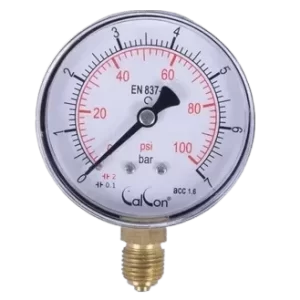Digital Pressure Switch
An electronic pressure switch operates using an electronic pressure sensor—commonly known as a pressure transmitter—and incorporates its functionality. With built-in electronic switching elements, it can open or close an electrical circuit, making it suitable for basic control operations.
Description
A pressure switch is a flexible device used to monitor and regulate pressure in various industrial and commercial environments. These devices operate through mechanical components, providing dependable performance in environments where electronic solutions may not be suitable.
How Does a Pressure Switch Work?
Pressure switches rely on components like diaphragms, pistons, or bellows to sense pressure changes. When the pressure reaches a specific set point, the internal mechanism then triggers electrical contacts. As a result, this action enables accurate monitoring and control of systems such as pumps, compressors, and safety equipment, thereby promoting efficient performance and system protection.
Key Features and Benefits
- Exceptional Durability: Designed with robust components, these switches perform reliably even in harsh and challenging environments.
- Versatile Pressure Range: Suitable for both low and high-pressure applications, offering flexibility for various use cases.
- Cost-Effective Solution: Their straightforward design makes them an economical choice for managing and monitoring pressure.
- Customizable Settings: Adjustable pressure setpoints allow for fine-tuned activation and deactivation based on specific system requirements.
Applications of Pressure Switches
- HVAC Systems: Ensure proper air and fluid pressure control in heating, ventilation, and cooling systems for optimal performance.
- Industrial Automation: Play a crucial role in maintaining the safe and efficient operation of hydraulic and pneumatic systems.
- Safety Systems: Act as a fail-safe, triggering alarms or system shutdowns in cases of overpressure to protect equipment and personnel.
- Process Industries: Widely used in sectors such as oil and gas, chemical processing, and water treatment for reliable pressure management.
Why Choose Pressure Switches for Your Applications?
When dependable performance, ease of use, and durability are critical, pressure switches serve as an excellent choice. Due to their mechanical design, the pressure switch continue to operate reliably even in harsh environments where electronic alternatives may struggle. Widely adopted across numerous industries, these switches strike the right balance between efficiency and reliability, ultimately becoming a valuable component in pressure control systems around the world.





